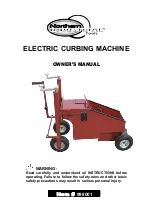
Page of 12
4
·
Extension Cord Use:
A. Use only ‘Listed’ extension cords. If used outdoors, they must be marked “For Outdoor
Use.” Those cords having 3-prong grounding type plugs and mating receptacles are to be
used with grounded tools.
B. Replace damaged or worn cords immediately.
C. Check the name plate rating of your tool. Use of improper size or gauge of extension cord
may cause unsafe or inefficient operation of your tool. Be sure your extension cord is rated
to allow sufficient current flow to the motor. For the proper wire gauge for your tool, see
chart.
CHART FOR MINIMUM WIRE SIZE OF EXTENSION CORD:
CORD LENGTH
Nameplate AMPS
25'
50'
100'
150'
0-6
18 AWG
16 AWG
16 AWG
14 AWG
6-10
18 AWG
16 AWG
14 AWG
12 AWG
10-12
16 AWG
16 AWG
14 AWG
12 AWG
12-16
14 AWG
12 AWG
(NOT RECOMMENDED)
If in doubt, use larger cord.
Be sure to check voltage requirements of the tool to your incoming power source.
·
Do not expose
power tools to rain or wet conditions. Water entering a power tool will increase
the risk of electric shock.
·
Do not let your fingers
touch the terminals of plug when installing to or removing from the
outlet.
·
Ground fault circuit interrupters.
If work area is not equipped with a permanently installed
Ground Fault Circuit Interrupter outlet (GFCI), use a plug-in GFCI between power tool or
extension cord and power receptacle.
PERSONAL SAFETY
·
Stay alert,
watch what you are doing and use common sense when operating a power tool. Do
not use a power tool while you are tired or under the influence of drugs, alcohol or medication. A
moment of inattention while operating power tools may result in serious personal injury.
·
Dress properly.
Do not wear loose clothing, dangling objects, or jewelry. Keep your hair,
clothing and gloves away from moving parts. Loose clothes, jewelry or long hair can be caught
in moving parts. Air vents often cover moving parts and should be avoided.
·
Use safety apparel and equipment.
Use safety goggles or safety glasses with side shields
which comply with current national standards, or when needed, a face shield. Use as dust mask
in dusty work conditions. This applies to all persons in the work area. Also use non-skid safety
shoes, hardhat, gloves, dust collection systems, and hearing protection when appropriate.
·
Avoid accidental starting.
Do not move the machine with your finger on the switch. Ensure the
switch is in the off position before plugging tool into power outlet. In the event of a power failure,
while a tool is being used, turn the switch off to prevent surprise starting when power is restored.
·
Do not overreach.
Keep proper footing and balance at all times.
·
Remove adjusting keys or wrenches
before connecting to the power supply or turning on the
tool. A wrench or key that is left attached to a rotating part of the tool may result in personal
injury.
TOOL USE AND CARE
·
Do not force
the curb machine
.
Tools do a better and safer job when used in the manner for
which they are designed. Plan your work, and use the correct tool for the job.






























